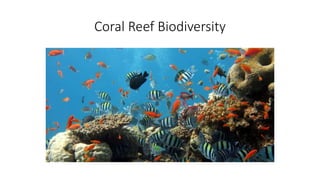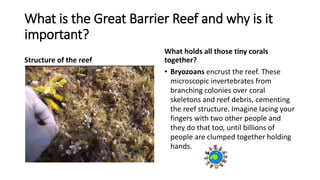Coral reef
- 2. What is the Great Barrier Reef and why is it important? Structure of the reef What holds all those tiny corals together? • Bryozoans encrust the reef. These microscopic invertebrates from branching colonies over coral skeletons and reef debris, cementing the reef structure. Imagine lacing your fingers with two other people and they do that too, until billions of people are clumped together holding hands.
- 3. The Great Barrier Reef • The Great Barrier Reef is the name given to the more than 3000 rainbow colored coral reefs that grow off Australia's east coast. In places, the reef is as much as one hundred miles wide. Although there are natural breaks in the reef, the Great Barrier Reef Marine Park maintains shipping lanes - wide cuts - through the reef so ships can get through.
- 4. The reef is very important to Australia's economy. • It provides food and jobs. 80% of the land along the reef supports agriculture - from fisheries to cattle grazing to crops. The reef protected beach offers white sand for lazing and sparking turquoise and aqua water for snorkeling, swimming, and surfing.
- 5. The Great Barrier Reef is one of the natural wonders of the world. • It is home to thousands of species of plants and animals. The reef itself provides food, pearls, treasure from shipwrecks, and tourism. It is of great interest to the scientific and medical communities of the world. Treatments for cancer, AIDS, asthma, arthritis, and other infections are being researched from organisms found in coral reefs.
- 6. The reef is in danger. • Run-off from land based agriculture, urban development, and aquaculture have all done their part to damage the reef. Oil spills and normal pollution from private boats and thousands of commercial vessels have damaged it. Tourists have damaged it. Infestation and disease have damaged it. Rather than use the passageways provided, ships push their way through the reef to save time and money. Sections of the reef are already dead. Other sections are dying. • Incredible UNESCO Sites in Danger of Disappearing www.thedailybeast.com
- 7. The Coral Reefs Vocabulary • Biotic factors – are the living components that affect an ecosystem. • Examples of biotic factors include disease-causing bacteria, invasive species, and humans. • Abiotic factors are the nonliving components of an ecosystem. Examples include temperature, salinity, and pH. • Invasive species – an introduced species that is harmful to native species. • Introduced species are organisms that do not naturally occur in a given region. • Not all introduced species are invasive species. Only species that have harmful effects are considered invasive.
- 8. Vocabulary • Coral – a class of marine animals in the phylum Cnidaria that are important reef builders in tropical oceans. • A coral colony consists of many tiny polyps. Each polyp contains a set of tentacles surrounding a central mouth. • Polyps of stony corals excrete exoskeletons of calcium carbonate. Over time, coral colonies can grow to large size. • Corals thrive in warm, shallow, clear, and nutrient-poor oceans • Coral reef – a complex and diverse marine ecosystem formed on the exoskeletons secreted by stony corals. • Coral reefs are found in shallow, clear waters in tropical regions of the world. • Coral reefs occupy less than 1% of the world’s ocean floor but contain over 25% of all marine species, flamingos, and many others.
- 9. Coral Reef Animals The Coral Reef Ecosystem Sponges have been a part of the coral reef ecosystem from early on. Several species of these porous animals inhabit reefs. Sponges provide shelter for fishes, shrimps, crabs, and other small animals. They appear in a variety of shapes and colors. The coral reef ecosystem is a diverse collection of species that interact with each other and the physical environment. The sun is the initial source of energy for this ecosystem. Through photosynthesis, phytoplankton, algae, and other plants convert light energy into chemical energy. As animals eat plants or other animals, a portion of this energy is passed on.
- 10. Sea anemones Sea anemones are close relatives of corals. Indo- Pacific reef anemones are known for their symbiotic relationships with clownfish and anemone fishes. An anemone's tentacles provide refuge for these fishes and their eggs. In return, anemone fishes may protect the anemone from predators such as butterflyfishes. Anemone fishes may even remove parasites from their host anemones. They help each other, so this is called a symbiotic relationship.
- 11. Green turtles Some sea turtles frequent reef areas. Green, loggerhead, and hawksbill sea turtles live in the warm waters of the Great Barrier Reef.
- 12. Parrotfish make WHAT?! For years, scientists believed parrotfish were destroying the reef, but studies have proven that when parrotfish are prevented from feeding along an area of the reef, the coral is “smothered” to death by the growth of algal mats. Parrotfish use chisel-like teeth to nibble on hard corals. These fish are herbivores and eat the algae within the coral. They grind the coral's exoskeleton to get the algae, and defecate sand. A single parrotfish can produce about five tons (10,000 lbs.) of sand per year!
- 13. Underwater cleaning stations Wrasses comprise a large group of colorful cigar-shaped fishes. Some species are known as cleaners, and set up cleaning stations along the reef. When a larger fish aligns itself at one of these cleaning stations, a cleaner wrasse removes parasites from the fish. The banded coral shrimp is an example of a cleaner shrimp. It removes parasites and dead skin from reef fishes.
- 14. Undersea food court Eels are one of the reef's top predators. These fishes live in crevices in the reef and venture out at night to hunt and feed. They have sharp teeth set in a powerful jaw. Eels eat small fishes, octopuses, shrimps, and crabs. Other fishes found on the reefs include angelfishes, butterflyfishes, damselfishes, triggerfishes, seahorses, snappers, squirrelfishes, grunts, pufferfishes, groupers, barracudas, and scorpion-fishes. Photos courtesy Creative Commons.
- 15. Swim in for a quick bite Some species of sharks, skates, and rays live on or near the reef. Others swim in to eat. Shark species include lemon, nurse, Pacific blacktip, white- tipped reef, and zebra sharks. These sharks as well as rays generally eat crabs, shrimps, squids, clams, and small fishes.
- 16. The reef's food web • Both schooling and solitary fishes are essential residents of the reef ecosystem. Fishes play a vital role in the reef's food web, acting as both predators and prey. Their leftover food scraps and wastes provide food or nutrients for other reef inhabitants.
- 17. Types of feeding • Food chain – a sequence of organisms in which each organism feeds on the one below. • Example: Algae Parrotfish Grouper Shark. • In this food chain, parrotfish eat algae, groupers eat parrotfish, and sharks eat groupers. • Consumer – an organism that obtains energy by feeding on organic materials. • Organic materials are carbon-based compounds produced by living things. • All animals, all fungi, and even some plants are consumers. • Coral reef consumers include fishes, sponges, and other animals. • Filter feeder – an organism that eats by straining food, such as plankton, from water. • Examples of filter feeders include sponges, manta rays, whale sharks, baleen whales, barnacles, clams • Grazer – an organism that feeds by eating plants, algae, and other immobile organisms. • Important reef grazers include parrotfish and long-spined sea urchins.
- 18. Predators that eat the reef Sea stars, sea cucumbers, and sea urchins live on the reef. The crown- of-thorns sea star is a well- known predator of coral polyps. Large numbers of these sea stars can devastate reefs, leaving behind only the calcium carbonate skeletons. In dead reefs, recently killed by the crown-of-thorns sea star, larger food and game fish are almost totally absent. Even deep-sea fish populations may be affected by this breakdown in the food chain. Crown of thorns starfish. (Photo credit: NOAA) www.unc.edu/
- 19. On your own • http://oceanworld.tamu.edu/students/coral/coral_quiz.htm After class, please click on the link to go to the interactive quiz. Take the quiz. Then make a screenshot of you quiz results. Email the screenshot to me. For five points extra credit, write a short sentence telling one new thing that you learned from this lesson. Type that into the chat box.
- 20. Extension Want to know more? Just click on the link. If it does not take you to the site, then copy and paste the url into a new tab and click “Enter”. info@fisheyeview.com ©1995 -2011 Quantum Leap Network, Inc. - All Rights Reserved http://www.fisheyeview.com/FVCamTimeLap se.html
- 21. Thank you! • Credits • 1) All video photographed and edited by Peter Mumby. http://www.aussmc.org/documents/OveHoegh- GuldbergPresentation.pdf • 2) Website and database design by John Hedley. • 3) Funding generously provided by The Royal Society, World Bank/GEF Targeted Research for Coral Reefs, Natural Environment Research Council, US National Science Foundation, Australian Research Council, Pew Fellows Programme, National Geographic Society, & Khalid bin Sultan Living Oceans Foundation. • Still photos courtesy: www.unc.edu/; NOAA, and Creative Commons





















